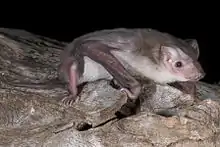Ozimops beccarii
Beccari's free-tailed bat (Ozimops beccarii) is a species of bat in the free-tailed bat family Molossidae found to Indonesia and Papua New Guinea.[1] It can be found in several habitat types, including savanna, tropical moist forest, and fragmented and urban habitat. It roosts in trees, caves, and buildings in small colonies.[1] This is a common species which is not considered to be threatened. The names Beccari's free-tailed bat or Beccari's mastiff bat once applied to populations in Australia.
| Ozimops beccarii | |
|---|---|
 | |
| Scientific classification | |
| Domain: | Eukaryota |
| Kingdom: | Animalia |
| Phylum: | Chordata |
| Class: | Mammalia |
| Order: | Chiroptera |
| Family: | Molossidae |
| Genus: | Ozimops |
| Species: | O. beccarii |
| Binomial name | |
| Ozimops beccarii Peters, 1881 | |
| Synonyms | |
| |
Taxonomy and etymology
Ozimops beccarii was described as a new species in 1881 by German naturalist Wilhelm Peters. The eponym for the species name "beccarii" is Odoardo Beccari. Beccari discovered the holotype on Ambon Island of Indonesia.[2] It was formerly considered native to Australia, but in 2014, the Australian population known as M. beccarii or M. beccarii astrolabiensis was distinguished as a full species, Mormopterus lumsdenae.[3]
Biology and ecology
The species is known to roost in human structures such as houses. Additionally, it has been found in Melaleuca tree hollows; one individual was documented using a cave.[1]
Range and habitat
Ozimops beccarii is found in Indonesia and Papua New Guinea. It has been documented from 0–300 m (0–984 ft) above sea level.[1]
Conservation
As of 2017, it is evaluated as a least-concern species by the IUCN. It meets the criteria for this classification because its apparently preferred habitat is abundant; the species is likely widespread; and no major threats have been identified. It is infrequently encountered and known from only about twenty localities. The low number of records is likely a result of lack of survey effort in the region, however. Its population likely exceeds 10,000 individuals.[1]
References
- Reardon, T.B. (2017). "Ozimops beccarii". IUCN Red List of Threatened Species. 2017: e.T13880A154818942. doi:10.2305/IUCN.UK.2017-2.RLTS.T13880A154818942.en. Retrieved 19 November 2021.
- Peters, W. (1881). "Über die Chiropterengattung Mormopterus und die dahin gehörigen Arten". Monatsberichte der Königlichen Preussische Akademie des Wissenschaften zu Berlin (in German): 484.
- Reardon, T. B; McKenzie, N. L; Cooper, S. J. B; Appleton, B; Carthew, S; Adams, M (2014). "A molecular and morphological investigation of species boundaries and phylogenetic relationships in Australian free-tailed bats Mormopterus (Chiroptera : Molossidae)". Australian Journal of Zoology. 62 (2): 109. doi:10.1071/ZO13082.
